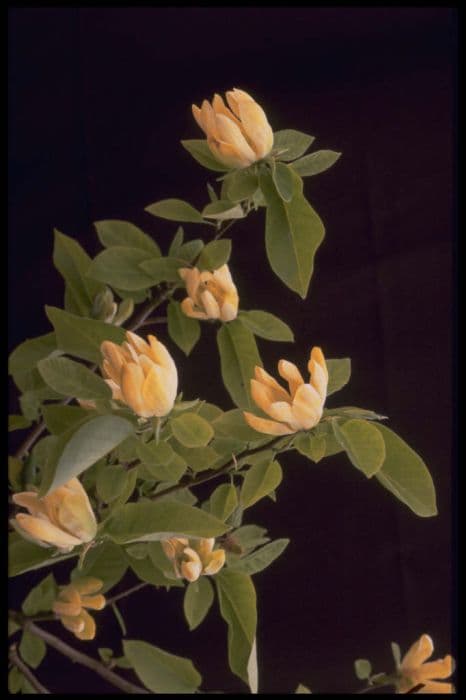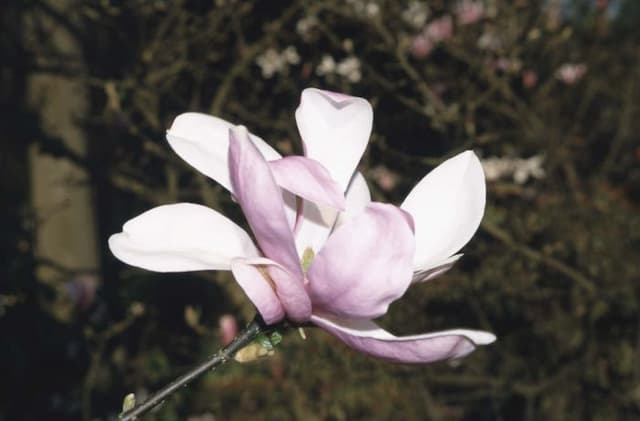Star Wars Magnolia Magnolia 'Star Wars'

ABOUT
Magnolia 'Star Wars' is a captivating plant known for its beautiful floral display. The flowers are particularly striking, large and lush with a distinctive tulip shape that captures the eye. Each flower is composed of many overlapping petals that exude an elegant pink-purple hue. The petals have a silky texture to the touch and often display a gentle gradation in color, starting with a deeper tone at the base and lightening towards the tips. The leaves of the Magnolia 'Star Wars' are also noteworthy. They grow abundantly, providing a dense canopy of foliage. Each leaf presents a broad, glossy surface that's deep green in color, offering a striking contrast to the vibrant flowers. During the blooming season, the contrast between the flowers and the foliage produces a stunning visual effect that makes this plant a highlight in any garden where it is featured. The overall form of the Magnolia 'Star Wars' is symmetrical and well-branched, giving it a balanced, harmonious look even when not in bloom. The branches stretch out and create a canopy that catches the light, highlighting the textures of the leaves and the contours of the impressive flowers. This plant is a joy to behold and provides an enchanting visual impact wherever it grows.
About this plant
 Names
NamesSynonyms
Magnolia 'Star Wars'
Common names
Magnolia 'Star Wars'
 Toxicity
ToxicityTo humans
The Magnolia 'Star Wars' is not known to be toxic to humans, and there are no common reports of poisoning from ingestion of this plant. However, as with any plant material, individual allergic reactions or digestive upset can occur if parts of the plant are ingested.
To pets
The Magnolia 'Star Wars' is also not known to be toxic to pets. It is generally considered non-toxic to dogs, cats, and other animals. However, ingestion of large quantities could potentially lead to gastrointestinal upset such as vomiting or diarrhea due to the physical nature of the plant material, not due to inherent toxicity.
 Characteristics
CharacteristicsLife cycle
Perennials
Foliage type
Deciduous
Color of leaves
Green
Flower color
Pink
Height
10-15 feet (3-4.5 meters)
Spread
6-10 feet (1.8-3 meters)
Plant type
Tree
Hardiness zones
7, 8, 9
Native area
Cultivar
Benefits
 General Benefits
General Benefits- Aesthetic Appeal: Produces large, attractive pink flowers that can enhance the visual appeal of gardens and landscapes.
- Spring Interest: Blooms in early spring, providing early seasonal color when many other plants are not yet in bloom.
- Wildlife Attraction: Flowers can attract pollinators such as bees, contributing to the local ecosystem.
- Shade Provider: As it matures, can provide shade in garden spaces, which can help in reducing soil moisture evaporation.
- Privacy Screen: Can be used as a natural screen to increase privacy due to its size and foliage density.
- Low Maintenance: Typically requires minimal pruning and is relatively easy to care for once established.
- Drought Tolerance: After establishment, some magnolia varieties show a degree of drought resistance, making them suitable for various climates.
- Tolerates Different Soils: Adaptable to a range of soil types, though it prefers well-drained, acidic soils.
 Medical Properties
Medical PropertiesThis plant is not used for medical purposes.
 Air-purifying Qualities
Air-purifying QualitiesThis plant is not specifically known for air purifying qualities.
 Other Uses
Other Uses- The large, sturdy leaves of the Magnolia can be used in floral arrangements as a natural and attractive backdrop to enhance the visuals of bouquets.
- Magnolia petals can be crystallized with sugar and used as edible decorations for cakes and desserts, providing a delicate floral flavor.
- Wood from the Magnolia tree can be used in furniture making, offering a strong material with a smooth, attractive grain.
- Dried Magnolia leaves can be incorporated into homemade potpourri mixes, adding a unique texture and appearance to the blend.
- Magnolia cones, the seed pods of the plant, can be painted and used as natural ornaments for craft projects or holiday decorations.
- The bark of the Magnolia tree, when peeled and dried, can be used in small pieces as mulch around other plants to help retain soil moisture.
- Magnolia flowers, due to their large size and shape, can be used as natural bowls to serve appetizers or desserts at garden parties.
- Leaves from the Magnolia can be pressed and dried to create botanical artwork or to use in scrapbooking and other paper crafts.
- Young twigs and branches of the Magnolia can be woven into wreaths and other forms of plant-based artistry, showcasing its flexibility and durability.
- The seed pods from Magnolia trees can be used in educational settings to teach children about seed dispersal and plant life cycles in a hands-on manner.
Interesting Facts
 Feng Shui
Feng ShuiThe Magnolia is not used in Feng Shui practice.
 Zodiac Sign Compitability
Zodiac Sign CompitabilityThe Magnolia is not used in astrology practice.
 Plant Symbolism
Plant Symbolism- Nobility: Magnolias are often associated with nobility because of their impressive appearance and the fact that they're one of the ancient flowering plants, symbolizing dignity and splendid beauty.
- Purity: The magnolia's white flowers are commonly linked to purity, suggesting innocence and clean beauty.
- Perseverance: Being a hardy plant that can withstand harsh conditions, magnolias symbolize endurance, determination, and persistence.
- Feminine Sweetness: The magnolia's delicate, sweet fragrance often leads to its association with feminine sweetness and gentleness.
 Water
WaterThe Star Magnolia should be watered deeply once a week, providing about 1.5 gallons for smaller shrubs and up to 4 gallons for larger trees during the growing season. During hot, dry spells, you may need to water twice a week. Soil should be kept consistently moist but not soggy. Reduce watering during the dormant winter months to when the soil feels dry to the touch an inch below the surface. It’s important to avoid overwatering as this can lead to root rot.
 Light
LightThe Star Magnolia benefits most from full sun to partial shade exposure. The ideal spot would provide it with at least 4 hours of direct, unfiltered sunlight daily while shielding it from harsh afternoon sun, especially in hotter climates.
 Temperature
TemperatureThe Star Magnolia thrives in temperatures between 70°F and 90°F but can tolerate winter cold down to about 20°F. It’s important to protect the tree from extreme cold winds and abrupt temperature changes that can damage flower buds. The ideal temperature range is comfortable for typical outdoor conditions in its growing zones.
 Pruning
PruningPruning of the Star Magnolia should be done to shape the tree, remove dead or damaged wood, and promote healthy growth. It is best pruned after flowering in late spring or early summer to avoid cutting off next year's buds. Pruning should be done annually or as needed to maintain its desired shape and size.
 Cleaning
CleaningAs needed
 Soil
SoilThe soil mix for Star Wars Magnolia should be rich, well-draining, and slightly acidic with a pH between 5.5 and 6.5. A mix of loamy soil, compost, and pine bark or peat moss is ideal to retain moisture while allowing excess water to drain.
 Repotting
RepottingStar Wars Magnolias in containers should be repotted every 2-4 years or when they outgrow their current pot, employing a soil mix that matches their acidity and drainage needs.
 Humidity & Misting
Humidity & MistingStar Wars Magnolia thrives in moderate to high humidity levels, around 50-60%, similar to their native woodland habitat.
 Suitable locations
Suitable locationsIndoor
Provide bright indirect light and keep soil moist.
Outdoor
Plant in partial shade, shelter from strong winds.
Hardiness zone
7-9 USDA
 Life cycle
Life cycleThe life of Magnolia 'Star Wars', commonly known as 'Star Wars' magnolia, starts as a seed that germinates when exposed to the right conditions of warmth and moisture in spring. After germination, the seedling grows into a young plant, with roots establishing themselves in the soil and a stem that starts to develop leaves. During its growth phase, the plant undergoes vegetative growth, forming a woody structure and foliage, which can take several years before it reaches maturity and is capable of flowering. The maturity stage is marked by the magnolia's spectacular display of large, pink to purple star-shaped flowers, typically blooming in early to mid-spring, depending on the climate. After pollination, which is often assisted by bees and other insects, the flowers give way to cone-like fruit that contains the seeds. The cycle continues when these seeds are dispersed, either by wind or wildlife, to start the process anew.
 Propogation
PropogationPropogation time
Spring-Early Summer
Propogation: The most popular method of propagating the Magnolia 'Star Wars', a beloved ornamental tree known for its large, striking flowers, is by semi-hardwood cuttings. This is typically done in late summer. Cuttings should be about 4 to 6 inches long (10 to 15 centimeters) and taken from a healthy branch. The cutting is then treated with a rooting hormone to facilitate the growth of new roots. The hormone-treated end is then planted in a well-draining soil mix, kept moist, and covered with a plastic bag or placed in a propagation case to maintain high humidity around it. Roots generally begin to form within weeks, after which the new sapling can be gradually acclimated to outside conditions before being planted out in a permanent location the following spring.



![Magnolia [Black Tulip]](/_next/image?url=https%3A%2F%2Fplants-admin.emdemapps.com%2Fimages%2Fplants%2F%2Fimages%2F604b590290fc7.png&w=640&q=75)





